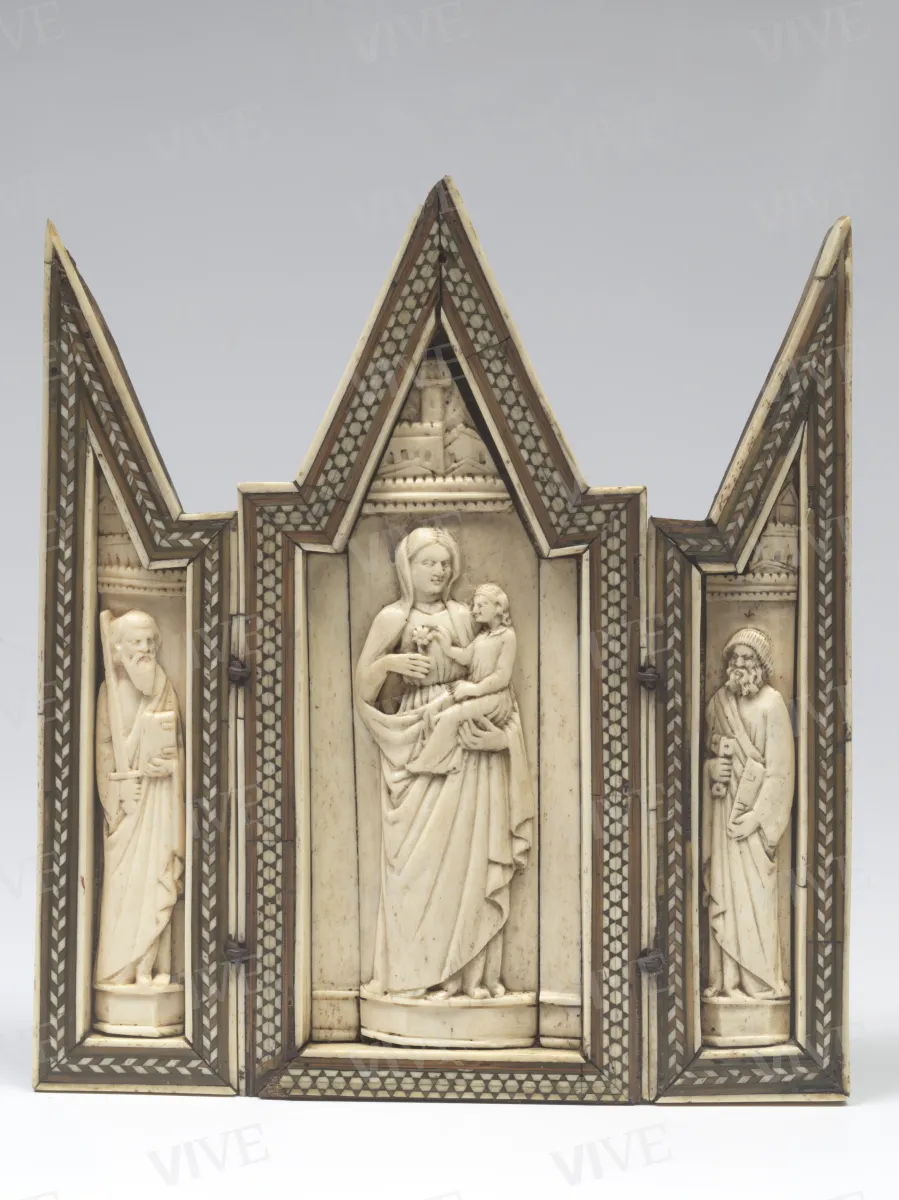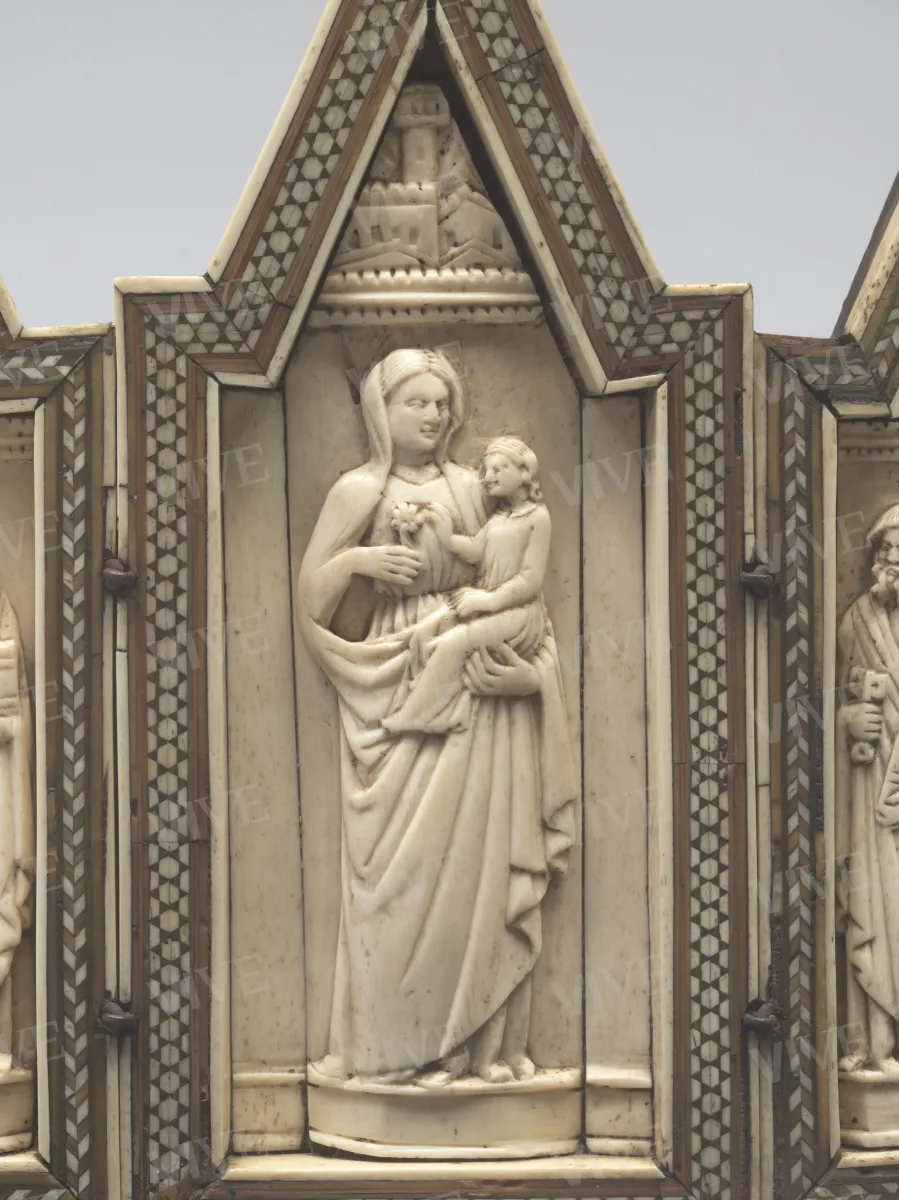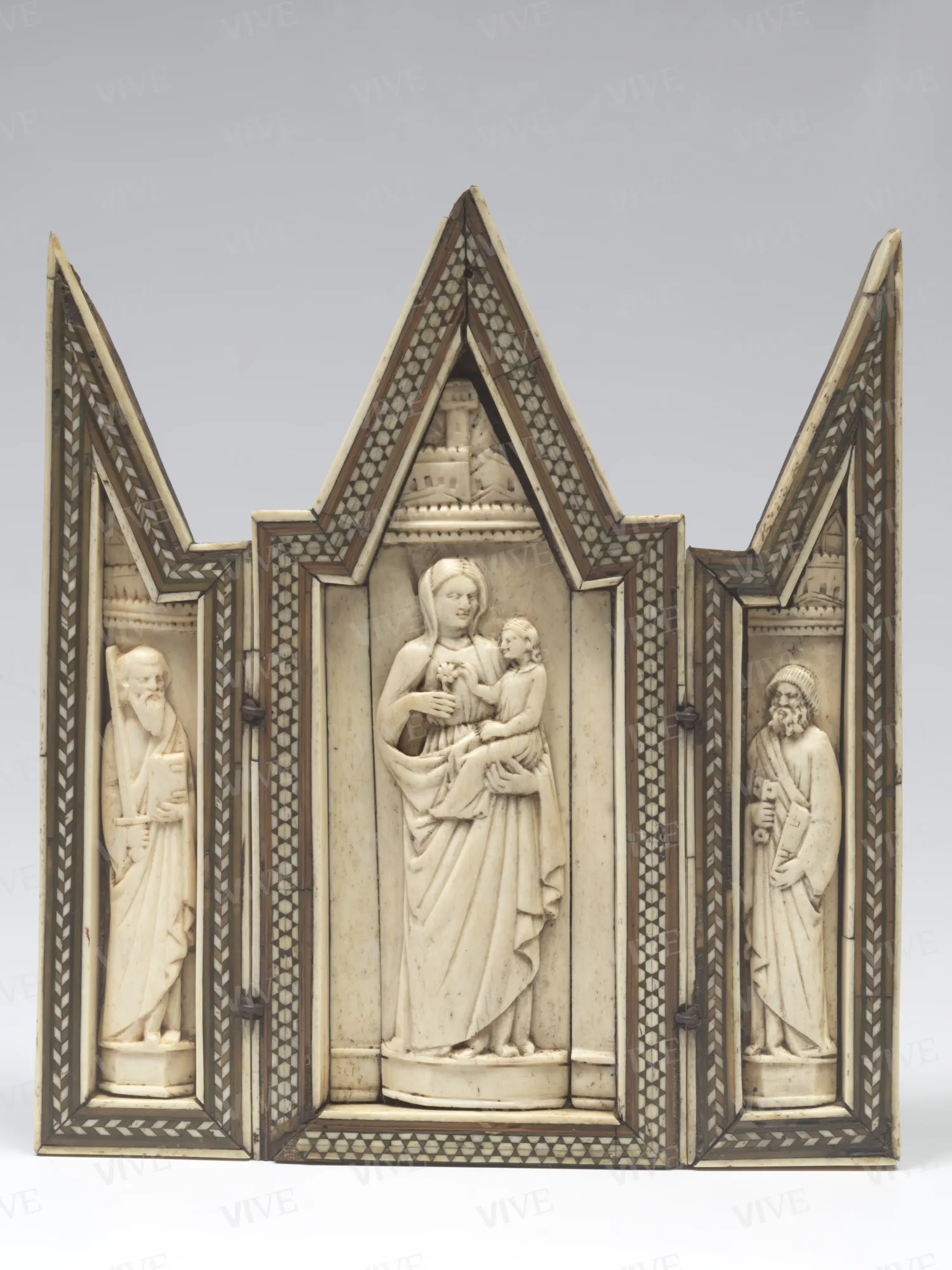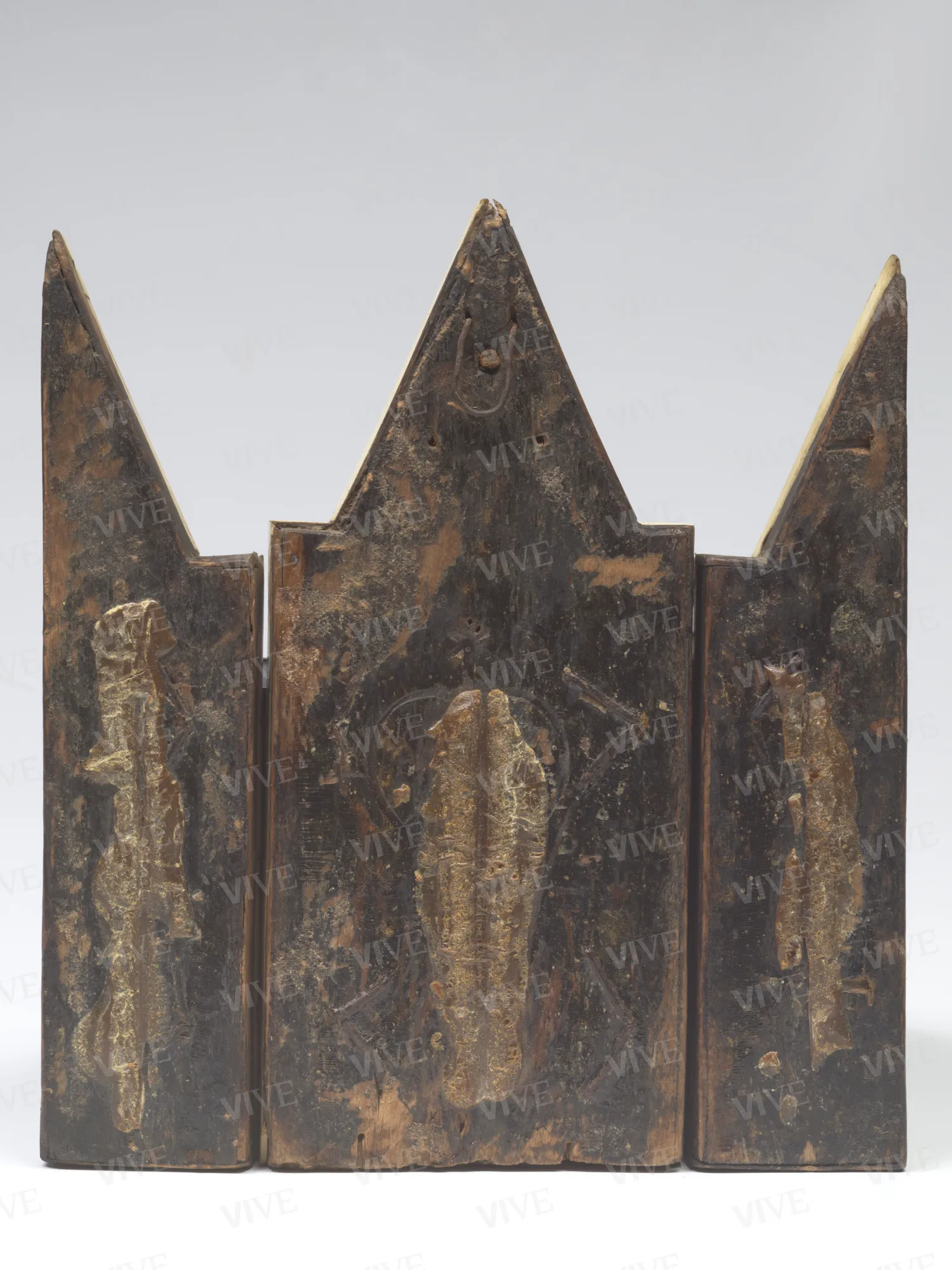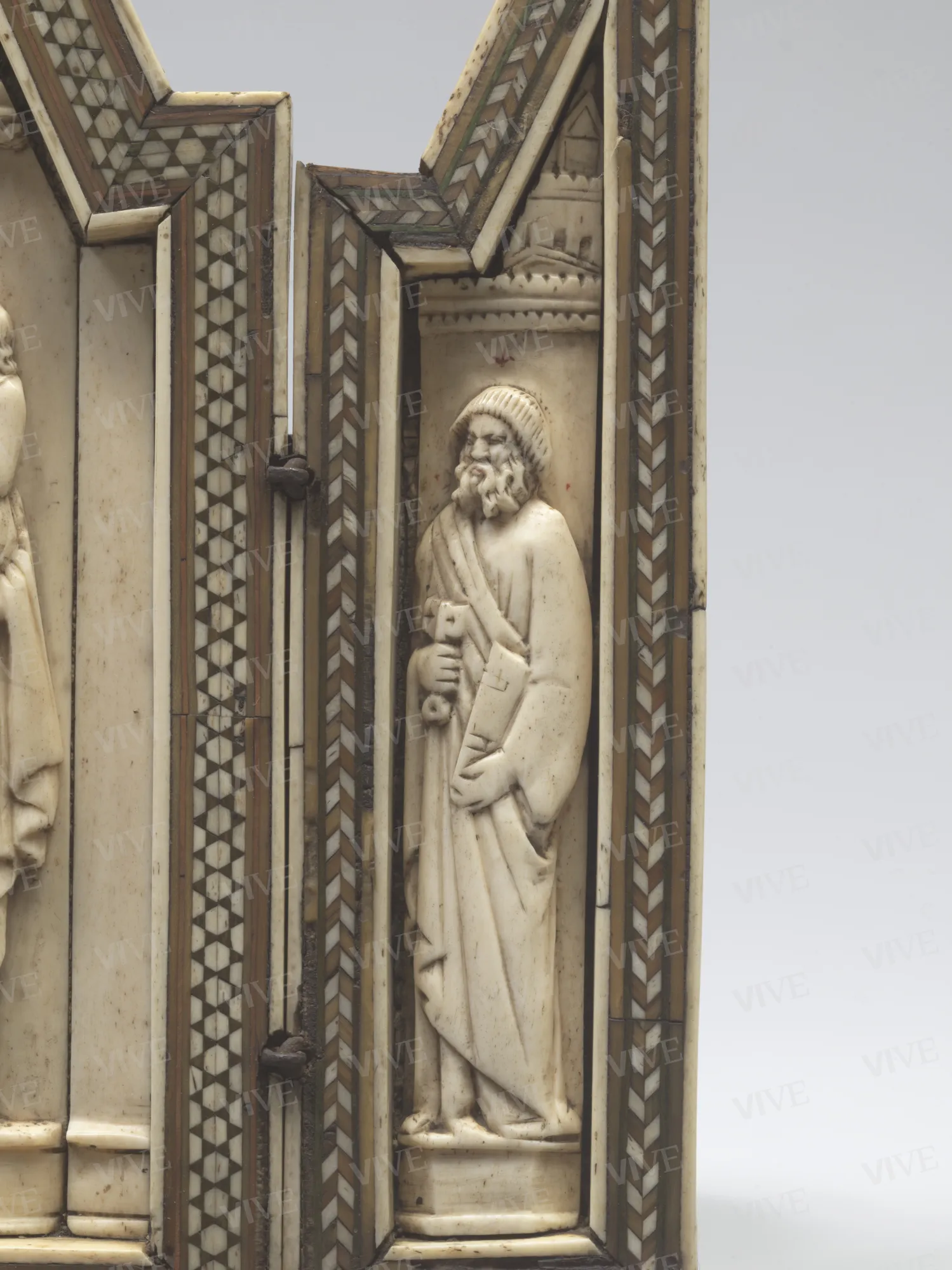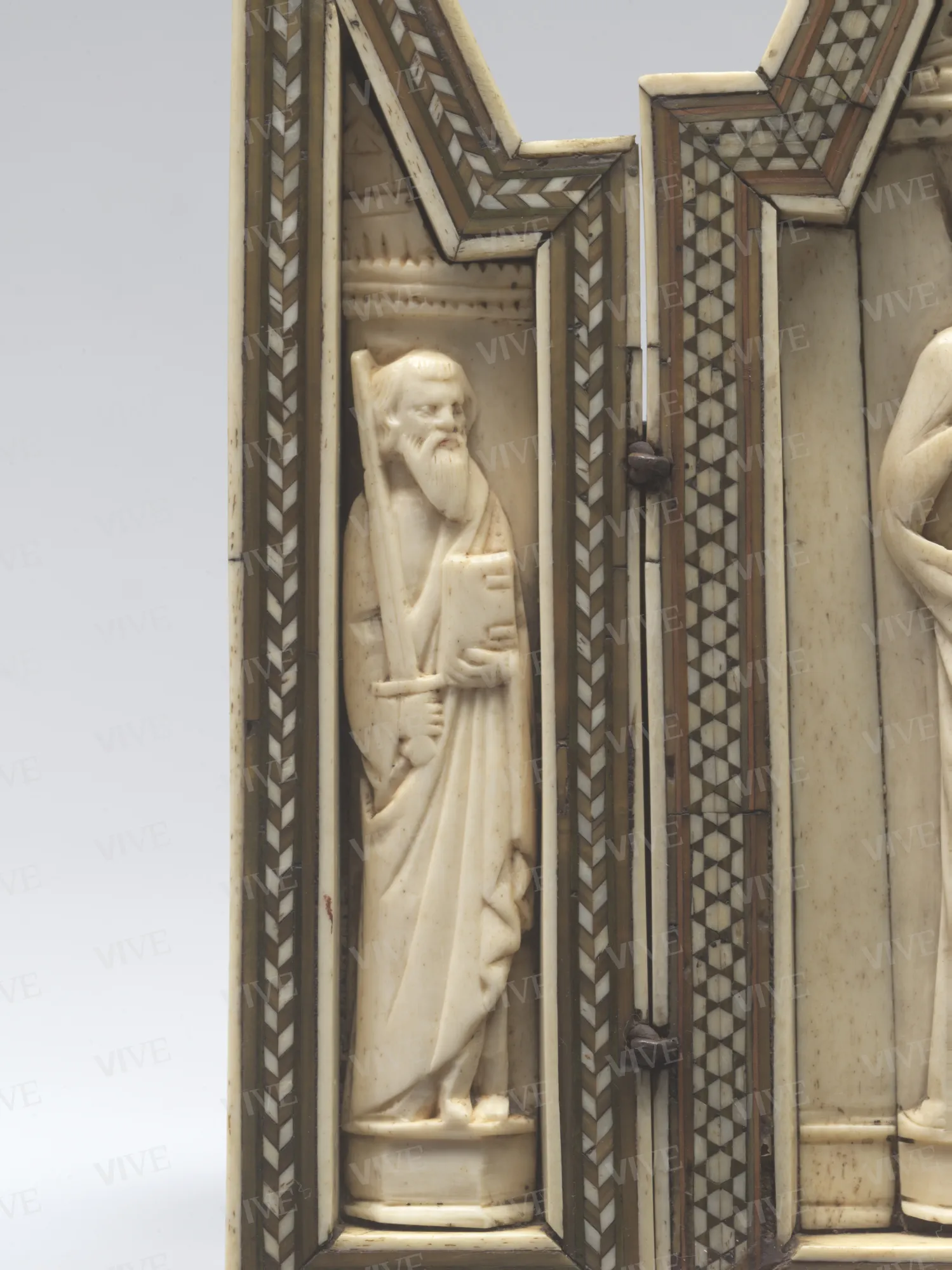Triptych with the Virgin and Child, and Saints Peter and Paul
Embriachi workshop Late-14th–early-15th century
The central body of the triptych, which has been cropped and deprived of its original base, contains the Virgin holding the Child with her left arm and handing him a flower with her right. To her right is Saint Paul, to her left Saint Peter. The top part of each panel, on the other hand, contains architectural images. The three elements of the triptych, hinged together with riveted caps, are profiled by inlaid frames with herringbone and five-pointed star motifs. The traces of mastic on the back date from when the work was attached to a support that was later removed.
The central body of the triptych, which has been cropped and deprived of its original base, contains the Virgin holding the Child with her left arm and handing him a flower with her right. To her right is Saint Paul, to her left Saint Peter. The top part of each panel, on the other hand, contains architectural images. The three elements of the triptych, hinged together with riveted caps, are profiled by inlaid frames with herringbone and five-pointed star motifs. The traces of mastic on the back date from when the work was attached to a support that was later removed.
Details of work
Catalog entry
Artifacts made from carved, juxtaposed ox bones on wooden supports profiled by ornamental inlaid bands have for years been confirmed by scholars to be products of the so-called Embriachi workshop. The workshop takes its name from Baldassarre Ubriachi, a Florentine merchant who, first in Florence and then in Venice, headed a large workshop, directed at least in its early phase by the Florentine carver Giovanni di Jacopo. To date the only works that have been irrefutably linked to the Embriachi workshop through documentary means are the large chests and the large triptych made in 1400 for the Carthusian monastery of Pavia and commissioned by Gian Galeazzo Visconti. Alongside this aristocratically commissioned production, in the late fourteenth century, the workshop also accepted commissions from a middle-class urban clientele. If wedding caskets or chests are the artifacts most often found still extant, the production of triptychs intended for private devotion were certainly not of secondary importance. Some of these offered complex figurative cycles arranged in two orders and depicted scenes from the New Testament; others, like this triptych, offered instead a central depiction—usually the Crucifixion or the Virgin and Child—with angels and saints in the side doors. Such triptychs are usually dated to between the end of the fourteenth century and the beginning of the fifteenth (Merlini 1991; Tomasi 2010, pp. 90–96). In terms of its iconography, the Palazzo Venezia triptych juxtaposes the Virgin and Saints Peter (with keys and book) and Paul (with book, sword, and long beard). This series of figures in Embriachi triptychs is one of the most common. The Virgin Mary in the central compartment (with or without other saints) and Peter and Paul in the two side panels are found in the triptychs held in the Museo Civico in Brescia (Guido 2001, p. 41), the Vatican Museums (Guido 2001, p. 33), the Museum and Treasury of Monza Cathedral (Guido 2001, p. 38), and the Cini collection in Venice (Tomasi 2016). Peter and Paul also appear on either side of the Crucifixion in the triptych at the Tiroler Landesmuseum in Innsbruck (Merlini 1991, p. 59, fig. 18) and in that of the cathedral of Avignon (Tomasi 2010, p. 407, fig. 29). The presence of these two main apostles on either side of the Virgin is not necessarily a sign that it was commissioned by a Roman client, as has been suggested (Castellani 2016, p. 25); Michele Tomasi has posited that the figures should be interpreted as a hymn to Mary as the Church Mother (Tomasi 2016). It is also worth noting that the Palazzo Venezia triptych is the only known triptych that depicts Mary in the act of offering a flower to her son—she is generally shown handing the Child a bird, consistent with the pictorial and sculptural models widespread at the time in Florence, the city of origin at least of the first Embriachi carvers. Stylistically, the Virgin of the altarpiece in question resembles the Virgin carved on a triptych fragment in the Museo Nazionale in Ravenna (Martini 1993) and the Madonna in a triptych in the British Museum in London (Dalton 1909, p. 135, no. 396). These figures, with their scantily draped robes stopping just above the waist, all offer a solid construction where the drapery ends in sharp folds that are interrupted as they touch the ground. Other similarities can also be found with Saints Peter and Paul, especially Saint Peter’s canopy-like hair, which is found, among other examples, in the Innsbruck Saint Peter triptych (Merlini 1991, p. 59, fig. 18). Even though they are highly stylized, the architectural elements in the triptych—a palace with a tower above the Virgin, a building with a gabled roof in the minor wings—are an often repeated motif in other Embriachi triptychs, such as, for example, in the lower registers of the side panels of the large triptych in the Royal Ontario Museum in Toronto (inv. 921.8.1). In general, this idiosyncratic way of representing architecture makes sense considering the Florentine background of the carvers working in the workshop during its early phase (Tomasi 2001, pp. 54–55). This observation would in turn date the triptych to between the end of the fourteenth century and the early fifteenth century. Although such an early date has been brought into doubt (Bernardini 1917, p. 41), it seems highly likely that the altarpiece in Palazzo Venezia was created in the very early years of the fifteenth century, especially considering the way the workshop made important stylistic changes in the early decades of its activity.
Giampaolo Distefano
State of conservation
Base no longer extant.
Exhibition history
Priverno, abbey of Fossanova, Il trittico della bottega degli Embriachi del Museo Nazionale di Palazzo di Venezia. Depositi in mostra #5 dal Museo Nazionale di Palazzo di Venezia, October 13–December 12, 2016.
References
Dalton Ormonde Maddock, Catalogue of the Ivory Carvings of the Christian Era with Examples of Mohammedan Art and Carvings in Bone in the Department of British and Mediaeval Antiquities and Ethnography of the British Museum, London 1909;
Bernardini Giorgio, Il nuovo Museo di Palazzo Venezia. Arte Bizantina - Oggetti in osso e in avorio, in «Rassegna d’arte», XVII, 1917, pp. 25-44;
Morey Charles Rufus, Gli oggetti di avorio e di osso del Museo Sacro Vaticano, Città del Vaticano 1936, p. 36, fig. 34;
Hermanin Federico, Il Palazzo di Venezia, Roma 1948, p. 293;
Merlini Elena, I trittici portatili della “Bottega degli Embriachi”, in «Jahrbuch der Berliner Museen», 33, 1991, pp. 47-62;
Martini Luciana, in Martini Luciana (a cura di), Oggetti in avorio e osso nel Museo Nazionale di Ravenna. Sec. XV-XIX, Ravenna 1993, pp. 72-73, n. 28;
Tomasi Michele, La bottega degli Embriachi, Firenze 2001;
Guido Sante, La Bottega degli Embriaghi: attorno al restauro di un piccolo trittico del Museo Cristiano Vaticano, in «Beni Culturali», 6, 2001, pp. 33-41 (p. 39);
Tomasi Michele, Monumenti d’avorio. I dossali degli Embriachi e i loro committenti, Pisa 2010;
Castellani Paolo, Bottega degli Embriachi, in Castellani Paolo (a cura di) Il trittico della bottega degli Embriachi del Museo Nazionale di Palazzo di Venezia. Depositi in mostra #5 dal Museo Nazionale di Palazzo di Venezia, Roma, catalogo della mostra (Priverno, Abbazia di Fossanova, 13 ottobre-12 dicembre 2016), Cinisello Balsamo 2016, pp. 24-25;
Tomasi Michele, in Bacchi Andrea, De Marchi Andrea (a cura di), La Galleria di Palazzo Cini. Dipinti, sculture, oggetti d’arte, Venezia 2016, pp. 274-275, n. 68.

